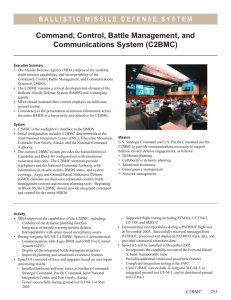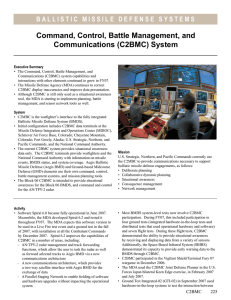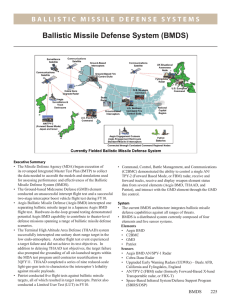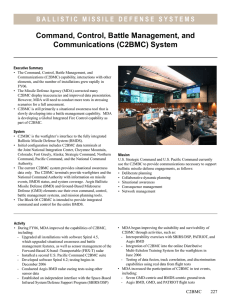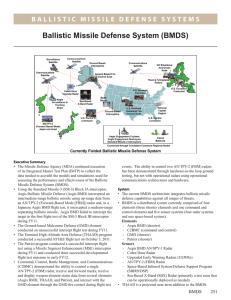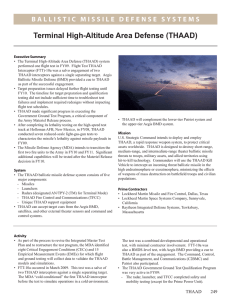Ballistic Missile Defense System (BMDS)
advertisement
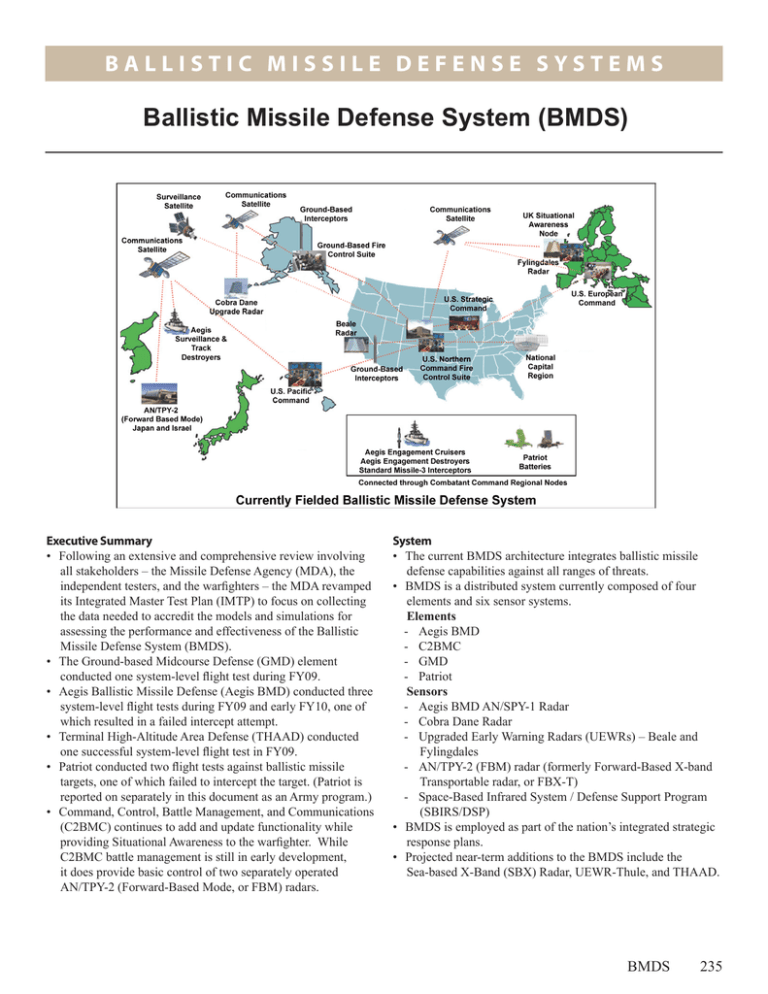
BALLIS T I C M ISSILE D EFENSE SYS T E M s Ballistic Missile Defense System (BMDS) Executive Summary • Following an extensive and comprehensive review involving all stakeholders – the Missile Defense Agency (MDA), the independent testers, and the warfighters – the MDA revamped its Integrated Master Test Plan (IMTP) to focus on collecting the data needed to accredit the models and simulations for assessing the performance and effectiveness of the Ballistic Missile Defense System (BMDS). • The Ground-based Midcourse Defense (GMD) element conducted one system-level flight test during FY09. • Aegis Ballistic Missile Defense (Aegis BMD) conducted three system-level flight tests during FY09 and early FY10, one of which resulted in a failed intercept attempt. • Terminal High-Altitude Area Defense (THAAD) conducted one successful system-level flight test in FY09. • Patriot conducted two flight tests against ballistic missile targets, one of which failed to intercept the target. (Patriot is reported on separately in this document as an Army program.) • Command, Control, Battle Management, and Communications (C2BMC) continues to add and update functionality while providing Situational Awareness to the warfighter. While C2BMC battle management is still in early development, it does provide basic control of two separately operated AN/TPY-2 (Forward-Based Mode, or FBM) radars. System • The current BMDS architecture integrates ballistic missile defense capabilities against all ranges of threats. • BMDS is a distributed system currently composed of four elements and six sensor systems. Elements - Aegis BMD - C2BMC - GMD - Patriot Sensors - Aegis BMD AN/SPY-1 Radar - Cobra Dane Radar - Upgraded Early Warning Radars (UEWRs) – Beale and Fylingdales - AN/TPY-2 (FBM) radar (formerly Forward-Based X-band Transportable radar, or FBX-T) - Space-Based Infrared System / Defense Support Program (SBIRS/DSP) • BMDS is employed as part of the nation’s integrated strategic response plans. • Projected near-term additions to the BMDS include the Sea-based X-Band (SBX) Radar, UEWR-Thule, and THAAD. BMDS 235 BALLIS T I C M ISSILE D EFENSE SYS T E M S • Advanced technology additions to the BMDS may include the following: - Airborne Laser (ABL) - Space Tracking and Surveillance System (STSS) Mission • The U.S. Strategic Command is responsible for synchronizing and integrating ballistic missile defenses employing U.S. Northern Command, U.S. Pacific Command, U.S. Central Command, U.S. European Command assets, and the BMDS to defend U.S. territory, deployed forces, friends, and allies against ballistic missile threats of all ranges, in all phases of flight. Initial capability will permit defending U.S. territory against simple ballistic missile threats and defending deployed forces, friends, and allies from theater-level ballistic missile threats. Activity • The MDA adopted a fundamentally different approach in developing the latest Integrated Master Test Plan (IMTP). The MDA Director and DOT&E jointly approved the 2009 IMTP revision, which for the first time encompasses the entire Future Years Defense Program. The plan uses a critical factors analysis (also referred to as Critical Engagement Conditions, or CECs) to drive test design, planning, and execution. The new test program focuses on collecting data that will be used to validate and accredit BMDS system- and element-level models and simulations. These models and simulations will ultimately be used to assess the performance and effectiveness of the BMDS throughout its operational battlespace. In addition, the IMTP also contains tests to satisfy other data needs through the use of Empirical Measurement Events (EMEs). The EMEs provide additional test data necessary to assess BMDS effectiveness and increase confidence in system performance. The IMTP also includes periodic dedicated operational test events, designated as warfighter-developed Epoch tests, which will be managed by the BMDS Operational Test Agency Team. • During the IMTP revision process, the MDA identified 100 CECs/EMEs for which flight and ground testing will collect data to validate the models and simulations. Of the 100 CECs/EMEs, the MDA identified seven system-level CECs and two system-level EMEs for which flight and ground testing will collect data to validate the system-level models and simulations. • GMD executed the Flight Test Ground-based Interceptor (FTG)-05 event in December 2008, which resulted in an intercept of the target. FTG-05 was the first time the GMD fire control facility in Fort Greely, Alaska, commanded an interceptor launch from Vandenberg AFB, California. UEWR‑Beale, SBX, Aegis BMD, AN/TPY-2 (FBM), and C2BMC all participated in this test event. 236 BMDS • U.S. Strategic Command, U.S. Northern Command, U.S. European Command, and U.S. Pacific Command will maintain Situational Awareness across the full mission engagement space using the C2BMC system. • The Army employs Patriot to provide theater defense for the deployed forces against short- and medium-range threats. The MDA has transferred Patriot to the Army; it is reported as an Army program. Prime Contractor - Integrator • The Boeing Company, Integrated Defense Systems, Missile Defense Systems, Huntsville, Alabama • The MDA executed the system-level event, Ground Test Distributed (GTD)-03, in March 2009 using fielded components and communications. • In FY09 and early FY10, the Aegis BMD program conducted three system-level intercept missions: Japanese Flight Test Standard Missile (JFTM)-2 in November 2008, Flight Test Standard Missile-3 (FTM)-17 in July 2009, and JFTM-3 in October 2009. In JFTM-2, the SM-3 Block IA interceptor failed to intercept the target. • THAAD performed one system-level flight test, Flight Test THAAD Interceptor (FTT)-10a, which occurred in March 2009. FTT-10a followed the September 2008 event, FTT-10, which was not completed due to a target failure. FTT-10a resulted in an intercept of the target, demonstrated THAAD’s salvo capability, and included a cue from Aegis BMD to THAAD. THAAD also performed safety, mobility, electromagnetic effects, and natural environments ground testing. • Patriot conducted two flight tests against ballistic missile targets: Flight Test 7-2 in March 2009, which resulted in a target miss due to an interceptor failure and flight test P6.5-4 in April 2009, which resulted in a target intercept. Flight Test 7-2 was the first intercept attempt using the new Missile Segment Enhancement interceptor. • C2BMC participated in a variety of ground-tests, flight-tests, and wargames, including GTD-03, Fast Contingency Analysis and Activation Team (Fast CAAT) East-Bravo, FTT-10a, FTG-05, Vigilant Shield 09, and Assured Response 09a. Assessment • The elements that comprise the present and future BMDS are at different levels of testing and maturity. - Prior to the latest Post Deployment Build 6.5 software release, Patriot provided mature and moderately BALLIS T I C M ISSILE D EFENSE SYS T E M s well‑understood capabilities against much of its theaterlevel missile threat set. This assessment is based on the number and complexity of test and evaluation events in which Patriot participated (both flight and ground testing) as well as combat operations during Operation Iraqi Freedom. Modifications and upgrades to Patriot designed to correct some deficiencies and introduce enhanced capabilities have undergone developmental testing, but have yet to be operationally tested. The Army Test and Evaluation Command will conduct a Limited User Test for the PDB 6.5 capability in the 1-2QFY10. - At the BMDS system level, the Aegis BMD provides a moderately well characterized capability against a majority of its theater-level missile threat set and its operational battlespace. At the unit level, the currently fielded configuration, Aegis 3.6, was previously found to be operationally effective and suitable. - THAAD testing indicates that it will provide a significant increase in capability against short-range threats when it is incorporated into the BMDS in FY10. The MDA plans to test additional significant capabilities after the Materiel Release of the first THAAD fire units in the fall of 2010. - To date, GMD has demonstrated a limited capability against a simple threat. While GMD flight testing to date is not sufficient to provide statistical confidence in its performance, post-flight reconstruction of flight test events has provided substantial evidence to support the validation process. The revised IMTP contains the additional flight tests necessary to collect the data to validate models and simulations. The successful completion of this task will increase confidence in the ability of these models and simulations to accurately assess system capability. Ground testing continues to demonstrate increasing GMD integration. • The inherent BMDS defensive capability against theater threats increased during the last fiscal year. DOT&E anticipates continued increases in this capability over time. The inherent BMDS defensive capability against strategic threats also increased; however, it remains limited. • Warfighters actively participate in all system-level BMDS testing as well as nearly all element testing. They perform operational roles, at individual elements through major combatant command levels, using operational tactics, techniques, and procedures. • During the past year, GMD interceptor design changes and parts obsolescence have resulted in hardware and software differences between fielded and flight tested interceptors. Such differences complicate assessments of the fielded GMD element. • C2BMC continues to add new functionality and improve existing functionality. It contributes to the warfighter’s Situational Awareness and currently provides basic management of two separately operated, forward-deployed AN/TPY-2 (FBM) radars. While communications and Situational Awareness have improved, challenges remain. To date, C2BMC has not matured sufficiently to provide an integrated, layered battle management capability against any class of threat missiles. Recommendations • Status of Previous Recommendations. The MDA satisfactorily addressed three of the previous five outstanding recommendations. The two remaining recommendations are still valid. • FY09 Recommendations. The MDA should: 1. Establish a process to monitor and review the execution of the approved IMTP. This process should also include oversight of interim changes and formal updates to ensure compliance with the intent of the approving stakeholders – the MDA, the operational testers, and the warfighters. 2. Revise the IMTP to incorporate the operationally realistic testing needed to support the phased, adaptive approach to providing missile defense for Europe. BMDS 237 BALLIS T I C M ISSILE D EFENSE SYS T E M S 238
